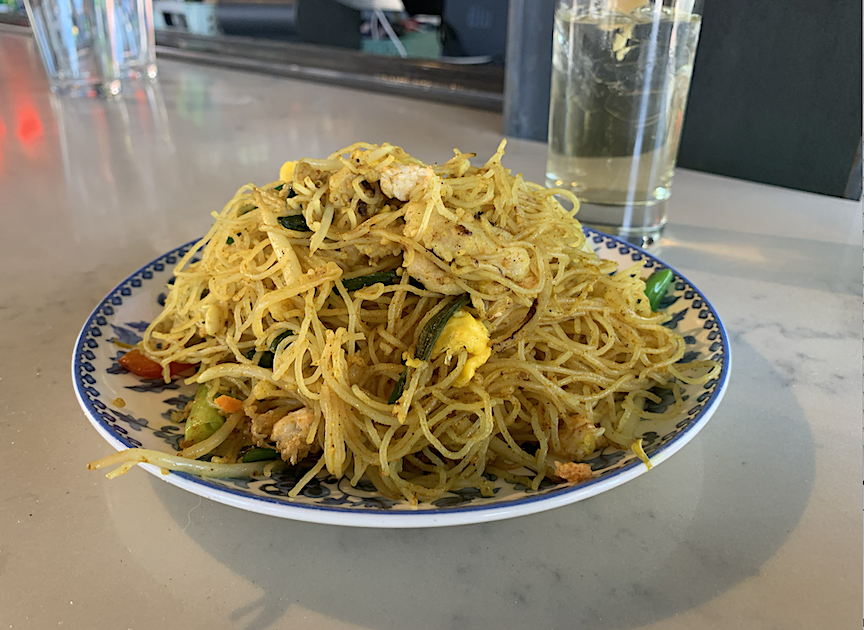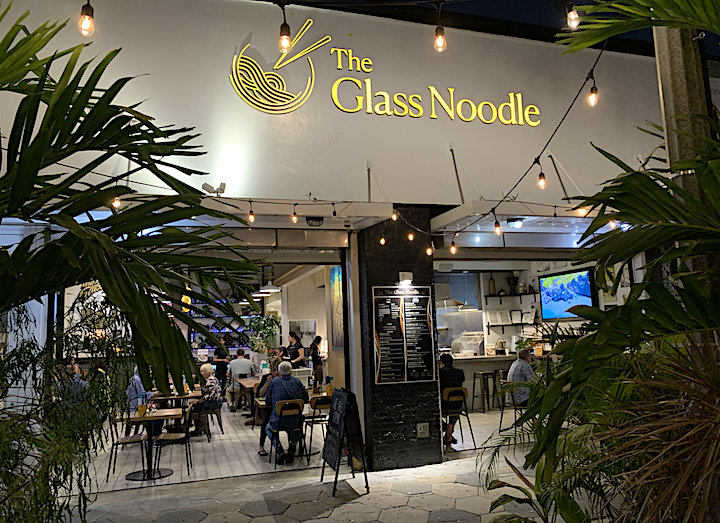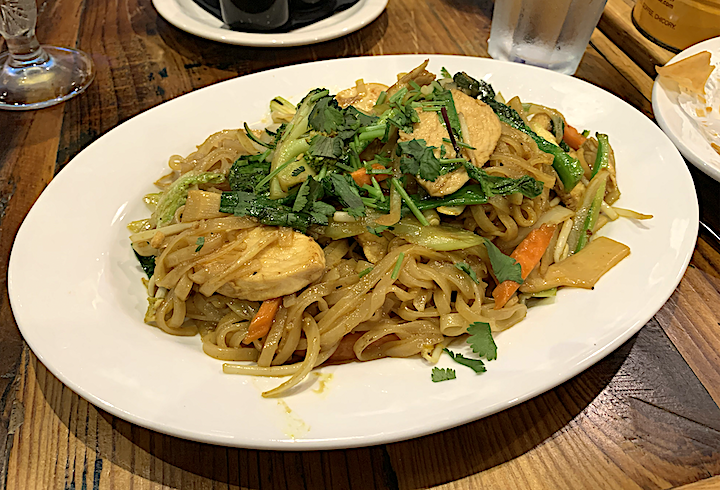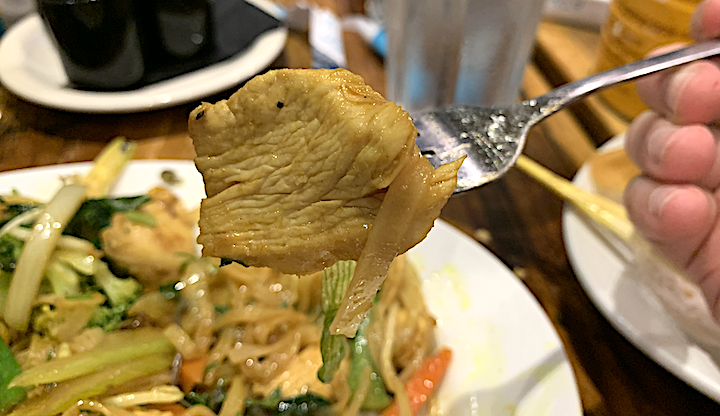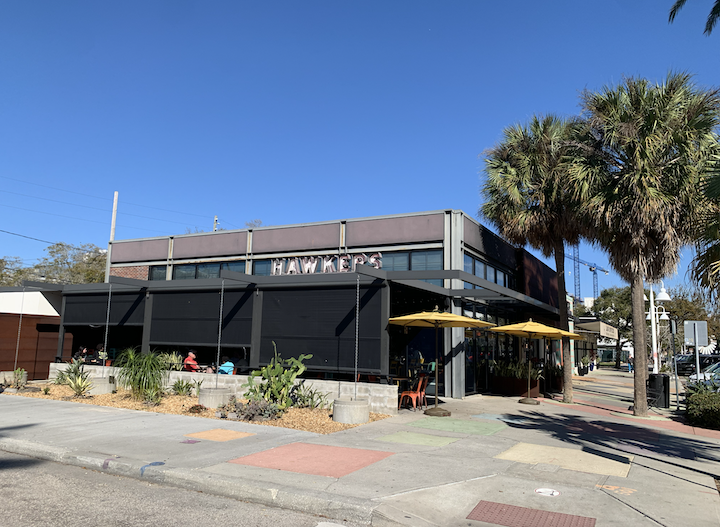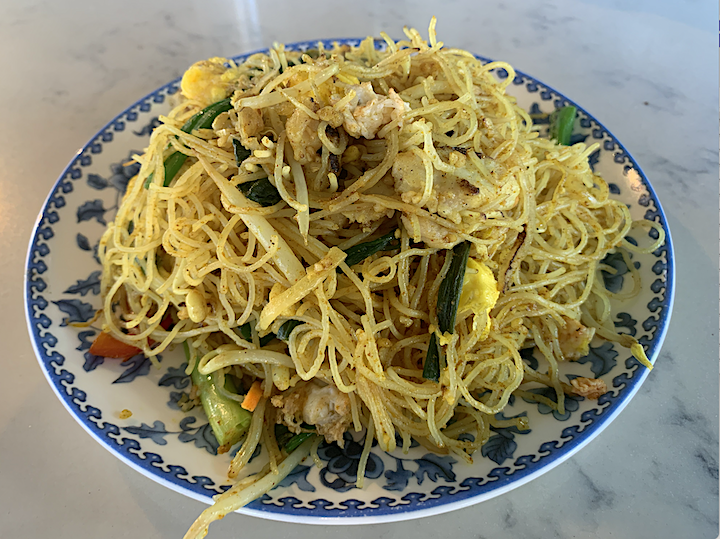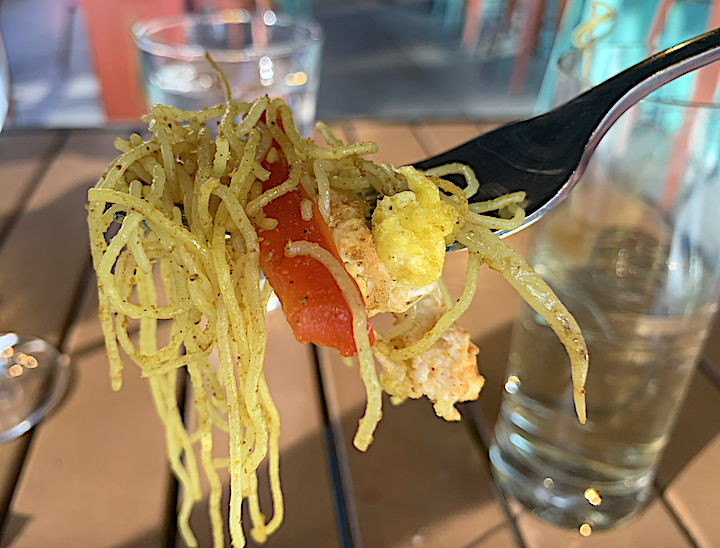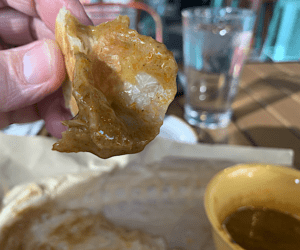Like most of you, I’ve had countless types of noodles — from lasagna to bean thread — doused in sauces ranging from marinara to Thai peanut. Until recently, though, I’d never knowingly had Singapore noodles (or Singapore Mei Fun). The name sounds tantalizing. It’s time.
Singapore noodles didn’t originate in Singapore, a small country at the southern tip of Malaysia that consists of 63 islands. Most sources agree that the stir-fry dish was probably created in Hong Kong. The best explanation I could find was that, after WWII, Cantonese chefs were eager to use the curry powder introduced via British colonies, and named it Singapore noodles as a nod to the cosmopolitan nature of both city-states.
There’s no absolute recipe, but the basics include rice vermicelli, curry powder, vegetables, and a protein — usually prawns, pork or chicken.
I found two Asian restaurants with Singapore noodles on the menu: The Glass Noodle and Hawkers: Asian Street Food, which are six blocks apart on Central Avenue in St. Pete.
THE GLASS NOODLE
Both garage-style doors were open when our dining quartet arrived at 7 p.m. on a Wednesday. It was our first visit. The brightly lit interior had several big-screen TVs showing nature scenes, a design choice that I found a bit odd. We settled into a small four-top.
The Glass Noodle, which opened in January of ’23, takes a decidedly pan-Asian tack, with noodle soups and dishes, rice dishes, and appetizers. The noodle entrees emanate from eight Asian countries, including Laos and Cambodia. All well and good, but I was on a mission for Singapore Noodles ($17.95, with chicken). We added an order of Crispy Veggie Spring Rolls ($5.95), and I got a can of 3 Daughters Beach Blonde Ale ($5). (They didn’t have it on draft, sigh.)
This dish looked attractive enough, although the noodles were larger and flatter than prescribed. The pieces of chicken were big — and bigger is not always better.
Texture and Taste
The menu said this dish included Indian curry powder, but the chef must’ve been feeling stingy that night because I couldn’t detect much spice at all, much less Indian curry.
The chunks of chicken breast were dry(ish) and burdened by a thick grain that made for chewy bites. Kind of like Asian “mall chicken.” I left a considerable pile on the plate. The noodles were fine, although I would’ve much preferred them skinnier. The sauce, more like a glaze, did not much of an impression.
In all, this helping of Singapore noodles didn’t take me anywhere.
HAWKERS
On Wednesday just after 3 p.m, it was 70 degrees under azure skies — the kind of weather that makes traffic brutal this time of year, although we did find a parking spot less than a block away. We chose a table in the covered patio. A potpourri of “classic” pop hits spilled out of the speakers. When “Danger Zone” came on, my first instinct was to run down Central holding my ears. I didn’t.
The restaurant has a vast pan-Asian menu consisting of mostly small plates. Along with Singapore Mei Fun ($14), I ordered Spring Rolls ($5) and a ginger ale, which turned out to be the Fever Tree brand ($4). And no trip to Hawkers would be complete without a round of Roti Canai (Malaysian-style, $9).
Appearance
This looked like the Singapore noodles I expected. Thin rice noodles — unsauced — were flecked with curry dust, with pieces of chicken (not big), veggies and scrambled egg mixed in. The plate was small, but the portion was not.
Texture and Taste
I’m so accustomed to eating Asian dishes coated in sauce that this dry noodle dish was a welcome change of pace.
The noodles stole the show — as it should be, don’t you think? They were stir-fried to a slight chewiness, and the yellow Malaysian curry gave them a bold flavor, without a spicy kick.
The crunchy bits, especially the red pepper, added delight to the bites, and the egg was just present enough. The chicken was moist and tender but basically flavor neutral.
A few words about the Roti Canai: Do yourself a flavor and get some of this. I have — many times. The flat-bread roti had a pastry-like quality — flaky, with a slight crispiness on the outside, moist on the inside. Tearing off chunks and dipping them is part of the fun. And then the payoff:
The curry sauce — a brown nectar, heaven-sent — is what takes this bread dish from really good to truly memorable. I never forget to get it.
And the Restaurant That Slings the Best Singapore Noodles Is …
I think I’ve pretty much given it away.
Hawkers.
Its version struck me as authentic, but regardless, it was delicious. I’m definitely going back for more.
My sense is that Singapore noodles have a fairly liberal set of parameters, but The Glass Noodle version fell well outside of them. I’m no expert, but they didn’t strike me as Singapore noodles at all.

